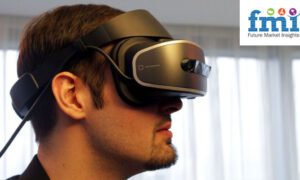Modern technology is in high demand as the gaming business continues to develop. Head-mounted displays have become more popular as users demand more immersive experiences. A Future Market Insights (FMI) report projects that the head-mounted display market would surpass US$ 10.47 Bn in 2021. Other industries besides the gaming industry will also experience increased demand, which will continue to produce profitable growth prospects.
To create a simulated training environment, head-mounted displays are frequently employed in military training applications (STE). STE is an augmented reality (AR) device that creates immersive military training. It aids in the improvement of soldiers’ training exercises involving deserts and mountains covered in snow, deep forests, and collaboration.
HMDs with AR/VR integration are used in training and simulations for a variety of purposes, including military simulations, battlefield visualizations, tactical augmented reality, digital twins, spatial orientation, situational awareness, weapon targeting, and digital terrain.
Head-mounted displays are becoming more common in the healthcare and educational fields because of advancing technology. The COVID-19 epidemic, when numerous schools and institutions worldwide were forced to retreat indoors for a few months to control the virus’s spread, has sped up the rate at which the transformation is occurring.
During the lockdown, sales of eyewear and head-mounted displays both experienced exponential growth, and the trend are unlikely to reverse soon. The survey claims that head-mounted displays accounted for the majority of market sales. Due to the growing demand for quick and dependable evolution among the gaming sectors, and aerospace, defense, and healthcare industries, the head-mounted segment is anticipated to experience a CAGR of 24.8 percent throughout the forecast period.
Key Takeaways: Head-Mounted Display Market. Driven by the rising demand for evolving technology, the head-mounted displays market will register over 16% y-o-y growth in 2021
- The U.S. will emerge as the leading market in North America, accounting for over 79% of sales
- Demand in the U.K. will rise considerably, enabling y-o-y growth at above 13% in 2021
- Inclination for advanced technologies and expansion of the gaming sector will support growth in Germany and France
- East Asia will emerge as a highly lucrative market with China at the forefront, followed by Japan and South Korea
COVID-19 Impact Analysis on head-mounted display Market
The COVID-19 outbreak’s repercussions will go well beyond just human health and safety. There are already indications that the virus will have a big effect on the AR/VR market and head-mounted displays. For the sake of public health and COVID-19 prevention, the outbreak has forced the postponement or cancellation of several sporting events.
On the other hand, it might increase the demand for VR/AR HMDs in the healthcare industry. Despite the pandemic, several international vendors have kept their attention on creating and innovating in AR/VR technologies by releasing cutting-edge products like smart glasses, like those made by Google and Microsoft.
The majority of countries went into lockdown during the COVID-19 epidemic. All sporting activities were rescheduled or canceled since people were forced to spend a specific amount of time at home. Because players were restricted to their houses, they found AR/VR gaming to be more appealing and entertaining. As a result, the market for head-mounted displays in AR/VR technologies has experienced tremendous development.
Increasing Demand in healthcare SectorDriving Growth
For patient care, medical marketing, disease awareness, and medical education, HMDs are employed in the healthcare sector.
Doctors can use VR headsets to create training scenarios while viewing the intricate features of any body component in 360° CGI reconstruction. Doctors now have easier access to the inside of the body thanks to virtual reality (VR) headsets.
By 2025, the AR and VR industries will reach US$35 billion, according to eInfochips, as a result of their adoption in the gaming, education, fashion, healthcare, and entertainment sectors.
Applications for HMDs in the healthcare sector include training in surgery, dental simulation, pain management, addiction treatment, telemedicine, stroke and dementia rehabilitation, and the treatment of depression and Post-Traumatic Stress Disorder (PSTD).
Doctors will soon be able to do surgery without entering the human body thanks to AR/VR headset technology. The use of technology improves precision while lowering the risk of injury and complications. Patients with PTSD and anxiety suffer significantly from VR. By allowing patients to experience virtual reality, VR headsets can help patients feel less stressed.
Who is Winning?
Market participants have been concentrating on developments. As businesses strive for a competitive advantage, spending on research and development will keep rising. Microsoft Corporation, Google, Samsung, BAE Systems, Elbit Systems, Huawei Technologies, HTC Corporation, Sony Corporation, LG Electronics, Thales Visionix, Inc., Xiaomi, and Avegant Corp. are a few of the top companies active in the market.































